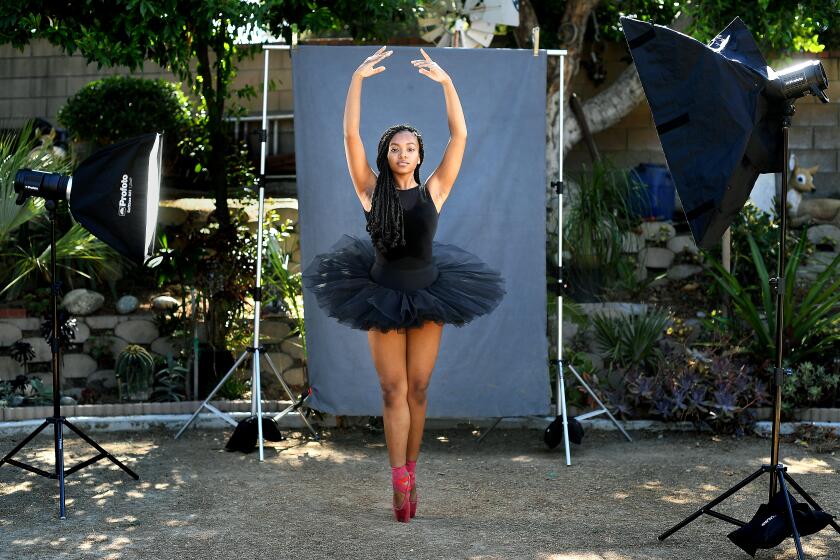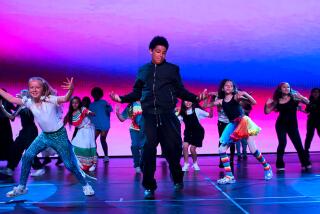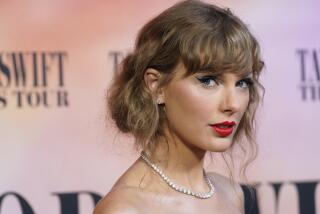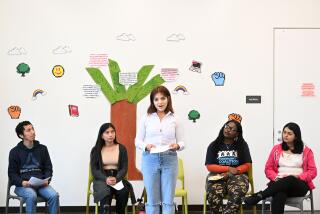Young artists reflect on their first semester of college during COVID-19

- Share via
Part of a year-end series revisiting subjects of some of our most popular arts articles of the year.
For freshmen starting college this fall, COVID-19 upended their education, as some colleges closed their campuses and offered only remote classes, while others were the sites of outbreaks.
For young artists studying music, dance, film, visual art, theater or other disciplines, remote or distanced learning brings unique challenges. Arts training relies on rehearsals, private instruction, ensemble shows and access to expensive equipment like cameras and software for projects.
In July, The Times spoke with five high school graduates anxiously preparing to enroll in university arts programs. Now, as they wrap up their first semester, we followed up to learn about their freshman experience — or, in the case of one student who decided to defer enrollment, find out if she’s content with her decision.
For those studying music, dance, film, visual art or theater at the college level, the pandemic threatens crucial in-person instruction and practice.
Natalie Aronno is studying dance remotely at UC Irvine

A first-generation college student, Natalie Aronno chose to study dance at UC Irvine, a school close to her home in South Gate, because her tuition would be fully covered by federal aid.
Aronno recently wrapped up the fall quarter from home, where all her classes were held over Zoom.
Her living room subs for a dance studio. The 18-year-old rearranged furniture, squeezing it into a corner, so she could take ballet and modern technique classes and a course called dance health and injury prevention. Throughout the quarter, she made a few upgrades to her space, including adding a piece of Marley dance flooring and a portable ballet barre to better mimic a proper dance studio.
“I ended up enjoying those a lot more than I expected, because the teachers really did pay attention to us, commenting on our technique, correcting us and really helping us grow,” she said.
In the fall, she also took writing, biology and a production class that pivoted from building sets and costumes to watching and writing about recorded live shows. One benefit to being entirely remote? Not having to commute to an 8 a.m. ballet class, she said.
Aronno’s living room also served as a space where she successfully auditioned and is rehearsing for a winter virtual show.
Like many students who began college remotely, the experience is not exactly what Aronno envisioned. She still mainly socializes with friends from the Los Angeles County High School for the Arts. “I don’t really talk to the people in my school right now,” Aronno said. “Unless we’re in class and we have breakout rooms.”
In high school, she was most excited about pursuing dance at the university level for the opportunity to learn from a new group of serious and passionate students.
“I was just looking forward to having a new group of people, but the reality is that I don’t get to share as much with them, and I don’t get to watch them as much as I usually would,” Aronno said. “That’s probably my biggest challenge, dancing alone every single day, and only being able to be with myself.”
Despite the challenges, and knowing that her winter and spring quarters will likely also be remote, she’s still happy she chose to study dance.
“My dance classes — even though they’re on Zoom and I do them alone, and I get tired of only being able to dance with myself — it definitely keeps me sane and brightens my mood every day,” Aronno said. “I don’t regret it at all.”
Dylan Kingdom moved on campus at University of Rochester to study French horn
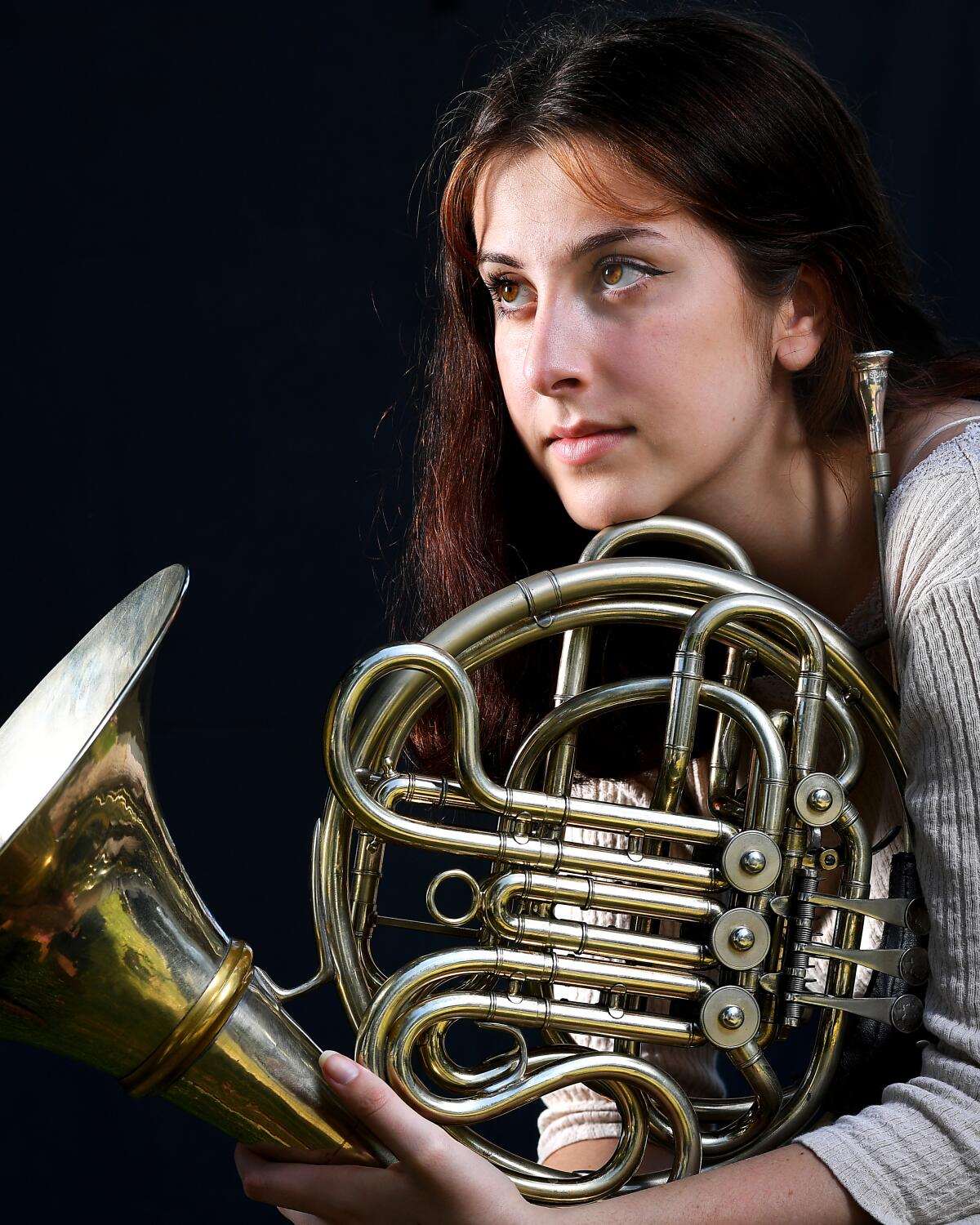
After moving from Burbank to upstate New York to study French horn, Dylan Kingdom began her college experience with two weeks in isolation.
The Eastman School of Music at the University of Rochester required the 18-year-old to spend 14 days at a hotel before she could move on campus. Kingdom could peek outside her hotel door only to gather meals or to set out trash.
“When I was in the quarantine, I was kind of freaking out,” she said. “Just like existentially for two weeks straight — like, ‘Oh, my God, I’m really doing this. I’m not going to see anybody for like four months.’”
But Kingdom’s first semester exceeded her expectations.
After completing quarantine and testing negative for the novel coronavirus, Kingdom moved into her dorm building, which was at about a third of its usual capacity. Students in dorms lived one to a room, Kingdom said, and strict rules were in place to prevent gathering.
“If somebody heard somebody else in a room, or more than one voice in the room … probably within five minutes, an RA [resident advisor] would come and kick them out and write a report.”
Some of Kingdom’s classes, including a fundamental course on theory and aural skills and some piano instruction, were online. Kingdom would record herself playing piano and send clips to a professor for feedback. Ensemble rehearsals took place in person, with students playing in a large theater, spaced about 8 feet apart.
She described using a beak-like mask made specifically for musicians as well as bell covers on the ends of brass and woodwind instruments for further protection from airborne particles and droplets.
“The precautions that they took — even though we all thought they seemed a little bit silly at first — we saw that there was really never any spread within the school of music, so I’d say that they worked pretty well,” Kingdom said.
Even with restrictions, Kingdom was still able to socialize outdoors and in large common areas, and she had several opportunities to perform.
Studying under her primary music professor was another factor that made the experience worthwhile.
“I think he has helped me grow, like a bazillion times better than I think I was at the beginning of the semester,” Kingdom said. “I think I made the right decision.”
For Thanksgiving break, Kingdom returned home to wrap up finals and the rest of the semester. She’s tentatively planning to return to campus in February.
“I am excited to go back. It’s kind of hard to keep yourself motivated when you’re at home.”
Avalon Lafosse deferred enrollment at Rhode Island School of Design
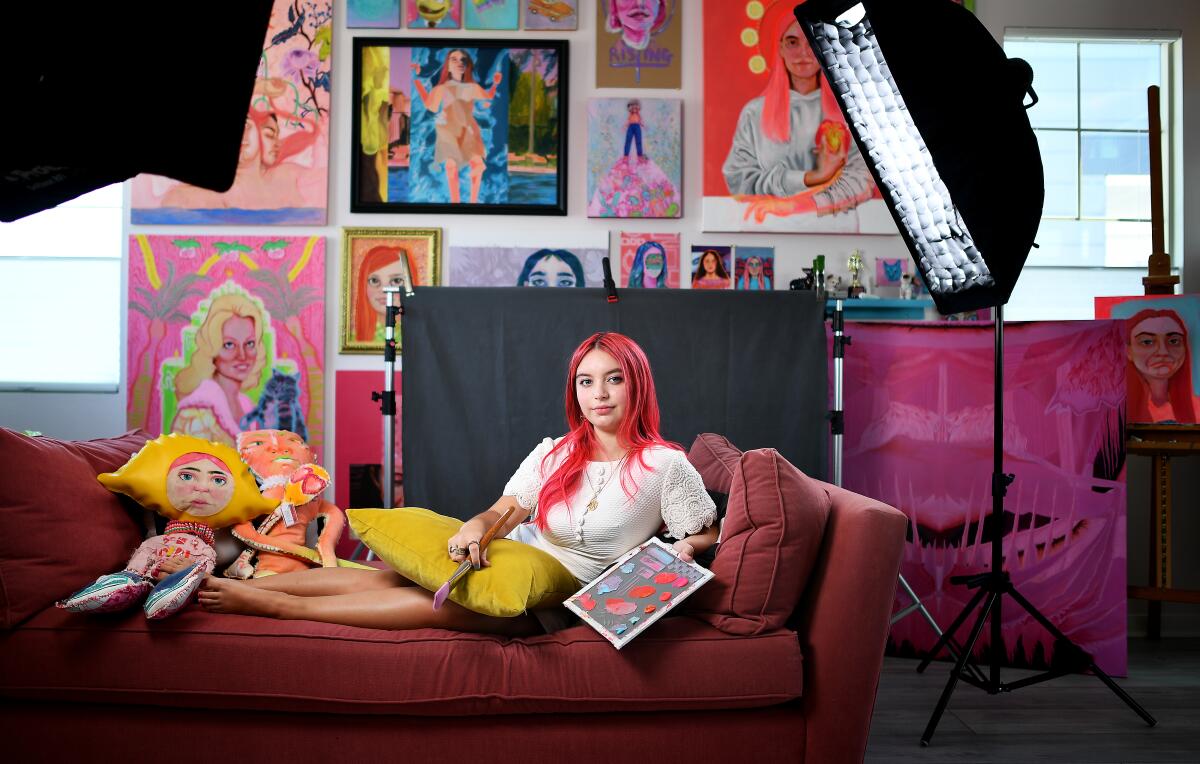
In April, 18-year-old Avalon Lafosse decided to defer her admission to the Rhode Island School of Design because of the limitations of virtual learning.
Over the last few months, Lafosse has been dedicating much of her time to the organization she created when she was 12, Art for Relaxation Therapy, which offers free art kits with supplies and art history and technique lessons to young people.
A few weeks ago, she received a grant to distribute 300 art packs to a children’s hospital in Orange County.
Lafosse said her schedule varies day by day. Some days she focuses on painting in her home studio in Irvine, working on a short film or editing her novel. She took a RISD continuing education illustration course and an animation class through the online learning platform Coursera. After Lafosse reached out, one RISD painting professor offered film and reading suggestions.
Although seeing her former classmates from the Orange County School of the Arts in college can make her feel anxious to be in class too, “A lot of good things have come from this gap year and the decision I made.”
With vaccines coming out, Lafosse also is feeling more hopeful. “It’s really important for me to continue to create,” she said, “and let myself find inspiration in the little things that I wouldn’t have ever noticed before.”
More to Read
The biggest entertainment stories
Get our big stories about Hollywood, film, television, music, arts, culture and more right in your inbox as soon as they publish.
You may occasionally receive promotional content from the Los Angeles Times.
